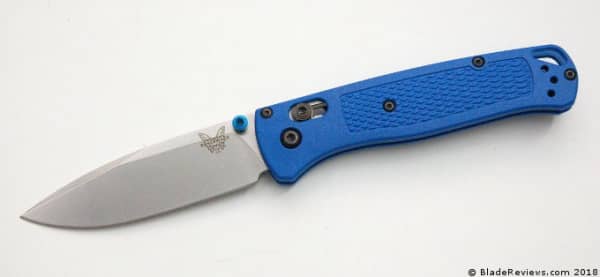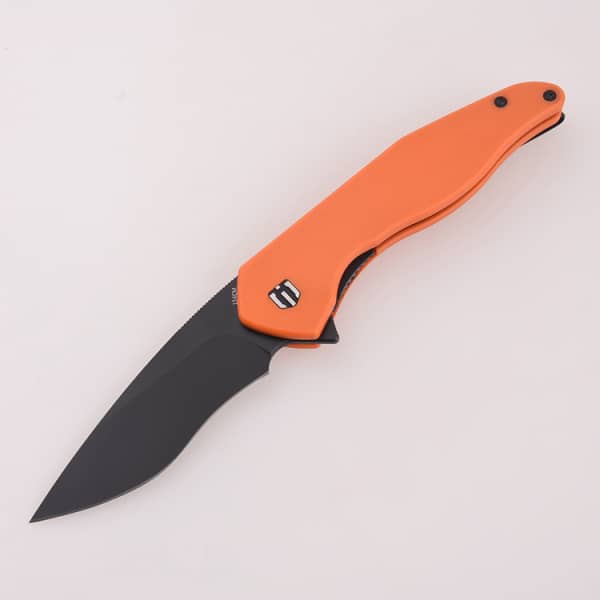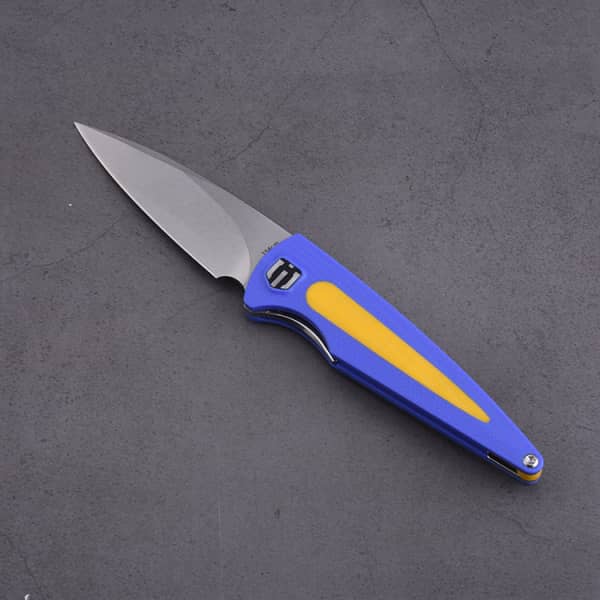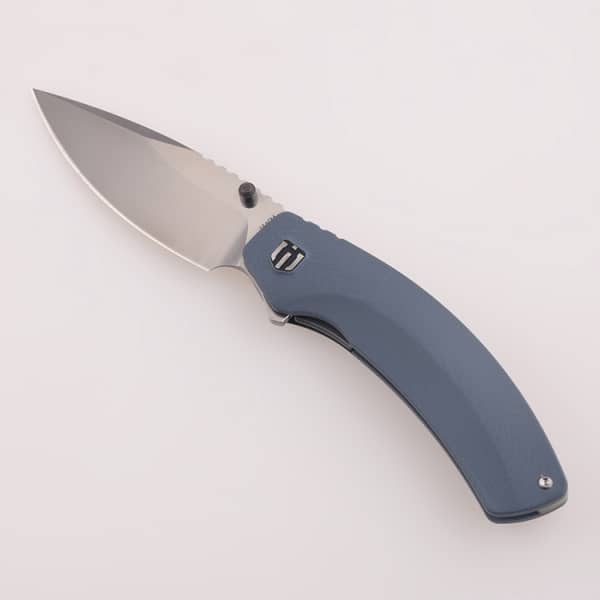When it comes to choosing a blade for your EDC knife, there are a variety of options to consider.
Among the most popular are the drop point, pinch point, and clip point blades. Each has unique features that make it ideal for certain tasks.
For example, the drop point blade is characterized by a convex curve that leads to a sharp point, making it ideal for cutting tasks that require precision and control.
The pinch point blade, on the other hand, has a narrow shape that allows for high-precision cutting, perfect for tasks that require a lot of control.
Meanwhile, the clip point blade features a concave curve that creates a sharp point, perfect for tasks that require piercing and stabbing.
Understanding the strengths and weaknesses of each blade can help you select the right one for your knife, depending on the purpose of its use.
Drop Point Blade
Drop point blades are a type of knife blade characterized by a convex spine that curves down from the handle to the tip.
This style of blade is one of the most popular and versatile and is used in a variety of applications including hunting, outdoor activities, and everyday carry.
The drop point blade originated in the early 19th century as an evolution of the clip point blade. It was designed to be stronger than its predecessor, with a thicker spine and a more gradual curve for better control when cutting.
The result was a blade that was both durable and easy to use, making it ideal for hunting and outdoor activities.
Drop point blades are typically made from stainless steel or other high-quality materials such as carbon fiber or titanium.
They come in a variety of sizes ranging from small pocket knives to large fixed-blade knives, making them suitable for many different uses.
Here is a sample of the Benchmade 535 Bugout drop point blade:
The drop point blade is well suited for tasks such as skinning game animals or slicing through tough materials like rope or leather. Its broad tip makes it ideal for piercing as well as slicing, while its curved shape allows for greater control when cutting.
Additionally, its thick spine provides strength and durability even when performing heavy-duty tasks.
When it comes to maintenance and care, drop point blades should be regularly sharpened with a whetstone or honing rod to keep them in top condition.
They should also be cleaned after each use with warm water and mild soap before being dried thoroughly and stored in a safe place away from moisture or extreme temperatures.
For anyone looking to purchase a knife featuring a drop point blade, there are many options available on the market today ranging from budget-friendly models to high-end custom pieces.
When choosing one, consider your intended purpose as well as features such as size, weight, handle material, and overall quality of construction before making your decision.
Pinch Point Blade
A pinch point blade is a type of knife or cutting tool that is designed with a unique tapered edge.
This tapered cutting edge helps to concentrate forces for maximum cutting efficiency, allowing the user to make precise and clean cuts.
Pinch point blades are typically made from high-carbon steel, which offers superior hardness and durability.
The shape of a pinch point blade is distinct from other types of blades, as it features a curved tip that tapers into a narrow point.
This design allows the blade to penetrate materials more easily and makes it ideal for slicing through tough surfaces such as leather or wood. Additionally, the curved tip helps to reduce the risk of accidental puncture wounds when using the blade in close proximity to the skin.
Pinch point blades are commonly used in industries such as construction, carpentry, leatherworking, and food preparation.
They can be used for tasks such as trimming wood or leather pieces, slicing vegetables, and opening boxes or packages.
When using a pinch point blade for any task, it is important to ensure that it is properly maintained and sharpened regularly in order to maintain its effectiveness over time.
Clip Point Blade
The clip point blade is a popular and versatile knife design, characterized by its crescent-shaped curve towards the tip, resulting in a fine and sharp point.
The origins of this blade can be traced back to ancient times, with Jim Bowie’s famous Bowie Knife being one of the most well-known examples of clip-point blades.
Today, they are widely used in various scenarios and industries, such as hunting, camping, survival, and everyday carry tools.
See the example below of a clip-point blade. This is the EG01A Viper:
The primary function of a clip point blade is precision cutting, piercing, and stabbing. Its sharp and tapered tip allows for easy penetration into various materials, making it ideal for tasks that require detailed work or finesse.
Some examples include carving, whittling, or dressing game during hunting trips. Additionally, the clip point’s narrow tip allows for greater control when performing intricate tasks, such as cleaning fish or cutting fruit.
In turn, this design feature has made the clip-point blade a popular choice among chefs and culinary professionals.
One notable advantage of the clip point blade over its drop point and pinch point counterparts is its ability to make deeper and more precise cuts while maintaining a thinner profile.
This makes it a great choice for users who prioritize precision and cutting performance in their knives.
However, the narrow and sharp tip of a clip point blade can also be seen as a potential drawback, as it may be more prone to breakage under extreme force or pressure compared to a thicker drop point or pinch point blade.
Despite the common misconception that clip point blades are less durable than other blade types, they can still prove to be reliable and tough with proper use, care, and maintenance.
Regular sharpening with a whetstone or diamond sharpening stone will ensure that your clip-point knife remains sharp and effective while cleaning with mild soap and water after use will help prolong its lifespan.
Finally, choosing a blade material known for its strength, such as carbon steel or high-quality stainless steel, will further enhance your clip-point knife’s durability and performance.
Defining Drop Point, Pinch Point, and Clip Point Blades
Let’s define each blade type to set a clear understanding of its design characteristics.
Drop Point Blade:
This blade has a convex curve that extends down from the handle towards its sharp tip, offering versatility in cutting tasks and control with both slicing and piercing actions.
Pinch Point Blade
With a narrow, curved shape, this blade is designed for high-precision cutting, ideal for tasks that require greater control and utmost accuracy.
Clip Point Blade
This blade features a concave curve that forms a sharp point, making it perfect for piercing and stabbing tasks while also providing excellent precision during cutting.
Now, let’s delve into the qualities that distinguish these blade types.
Blade Strength
Babaan
Known for its thick spine and gradual curve, the drop point blade offers excellent strength and durability for performing heavy-duty tasks without compromising its cutting ability or control. It lies in its ability to concentrate forces for optimal cutting efficiency.
For example, this EDC knife model called MT01A Colibri can precisely and sharply cut paper materials:
Clip Point
Although the clip point blade’s narrow and sharp tip is more prone to breakage than thicker designs, its overall strength remains commendable when constructed from high-quality materials like carbon or stainless steel.
Pinch Point
The pinch point blade offers the best of both worlds when it comes to strength and cutting performance, with its unique tapered edge allowing for maximum force concentration while also providing clean and precise cuts.
Kagalingan sa maraming bagay
Babaan
The drop point blade’s versatility is unmatched due to its ability to slice, chop, and pierce various materials with ease and precision. This makes it suitable for a wide range of applications, such as hunting, camping, and everyday carry.
Pinch Point
While the pinch point blade excels at high-precision tasks and intricate cuts, its specialized design may limit its versatility in broader applications.
Clip Point
Offering a combination of piercing and precision cutting capabilities, the clip-point blade is versatile in its own right but may not be as well-rounded as the drop-point blade.
Estetika
Babaan
With its practical design and gradual curve, the drop point blade may be considered less flashy compared to the clip point blade.
See this knife example: MS01A Hierophant
However, its simplicity lends it a timeless and classic appeal that has maintained popularity over the years.
Pinch Point
The pinch point blade’s unique tapered edge and narrow design make it a visually striking choice for users who appreciate a sleek and distinct aesthetic.
Clip Point
Often regarded as one of the most visually appealing blade types, the elegant curve and sharp point of the clip-point blade make it a popular choice for collectors and users seeking a stylish option.
Precision and Point Control
Babaan
Although the drop point blade offers excellent control, its broader tip may not provide the same level of precision as the pinch point or clip point blades when it comes to intricate tasks and detailed work.
Pinch Point
As precision is the pinch point blade’s most notable attribute, it surpasses both the drop point and clip point blades in terms of point control and accuracy during cutting tasks.
Clip Point
The clip-point blade provides impressive precision and control, especially during piercing and stabbing tasks, but it may not reach the same level of accuracy as the pinch-point blade.
Konklusyon
In conclusion, each blade type offers its own unique advantages and disadvantages when considering factors such as blade strength, versatility, aesthetics, precision, and point control.
The drop point blade stands out for its durability, versatility, and control, making it the most suitable choice for a broad range of applications.
Alternatively, the pinch point blade is ideal for those seeking a highly precise cutting tool with a sleek and distinct design. Finally, the clip-point blade offers users a stylish option with excellent precision and control during piercing tasks.
Ultimately, the choice of which blade type is most suitable will depend on the specific use case and user preferences.
By carefully examining these factors and understanding each blade’s strengths and weaknesses, one can make an informed decision that best meets their needs and requirements.
I-click upang magkaroon ng higit pang Shieldon EDC knife suppliers.








